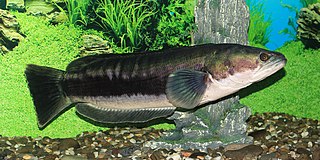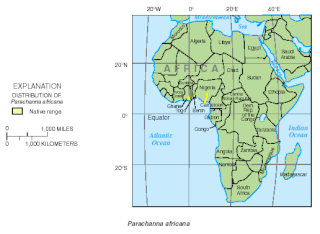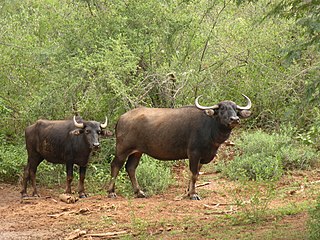
Bufo is a genus of true toads in the amphibian family Bufonidae. As traditionally defined, it was a wastebasket genus containing a large number of toads from much of the world but following taxonomic reviews most of these have been moved to other genera, leaving only seventeen extant species from Europe, northern Africa and Asia in this genus, including the well-known common toad. Some of the genera that contain species formerly placed in Bufo are Anaxyrus, Bufotes, Duttaphrynus, Epidalea and Rhinella.

Apes are a clade of Old World simians native to sub-Saharan Africa and Southeast Asia, which together with its sister group Cercopithecidae form the catarrhine clade, cladistically making them monkeys. Apes do not have tails due to a mutation of the TBXT gene. In traditional and non-scientific use, the term ape can include tailless primates taxonomically considered Cercopithecidae, and is thus not equivalent to the scientific taxon Hominoidea. There are two extant branches of the superfamily Hominoidea: the gibbons, or lesser apes; and the hominids, or great apes.

The Geoemydidae are one of the largest and most diverse families in the order Testudines (turtles), with about 70 species. The family includes the Eurasian pond and river turtles and Neotropical wood turtles. Members of this family are commonly called Leaf turtle.

Channa is a genus of predatory fish in the family Channidae, commonly known as snakeheads, native to freshwater habitats in Asia. This genus contains about 50 scientifically described species. The genus has a wide natural distribution extending from Iraq in the west, to Indonesia and China in the east, and parts of Siberia in the Far East. A particularly high richness of species exists in Myanmar (Burma) and northeastern India, and many Channa species live nowhere else. In contrast, a few widespread species have been introduced to several regions outside their natural range, where they often become invasive. The large and medium-sized Channa species are among the most common staple food fish in several Asian countries, and they are extensively cultured. Apart from their importance as a food fish, snakeheads are consumed in some regions as a traditional medicine for wound healing and reducing postoperative pain and discomfort, and collected for the international aquarium pet trade.

The snakeheads are members of the freshwater perciform fish family Channidae, native to parts of Africa and Asia. These elongated, predatory fish are distinguished by their long dorsal fins, large mouths, and shiny teeth. They breathe air with gills, which allows them to migrate short distances over land. They have suprabranchial organs, which are primitive forms of labyrinth organs, that develop when they grow older. The two extant genera are Channa in Asia and Parachanna in Africa, consisting of more than 50 species.
Human taxonomy is the classification of the human species within zoological taxonomy. The systematic genus, Homo, is designed to include both anatomically modern humans and extinct varieties of archaic humans. Current humans have been designated as subspecies Homo sapiens sapiens, differentiated, according to some, from the direct ancestor, Homo sapiens idaltu.

The forest snakehead is a species of snakehead, a fish of the family Channidae. Its range includes most of Southeast Asia and parts of southern China. It lives in forest streams and can reach 40 cm (16 in) in length. The forest snakehead is known in Thai language as pla krasong. Khmer language called it កញ្ជនជៃ, Indonesians named it kehung, while in Malaysia, they called it ikan bujuk in Malay Language and in Vietnamese its name is cá lóc dày

Channa gachua, the dwarf snakehead, is a species of fish in the family Channidae. The name "dwarf snakehead" is also used for several other species of small snakeheads. C. gachua is native to freshwater habitats in southern Asia, where it has a wide distribution from Iran to Indonesia. This fish is considered to be a species complex, a group of several closely related taxa with one name. It is likely at least three to four different species, and further research may differentiate them. A few species such as Channa harcourtbutleri have been separated from the complex in recent decades. The easternmost population of C. gachua is often recognized as a separate species C. limbata, while the isolated Sri Lankan population often is recognized as C. kelaartii.
Channa harcourtbutleri, the Burmese snakehead, is a species of snakehead endemic to Inle Lake and surroundings in Myanmar. Locally called nga ohn-ma, among aquarists it is considered one of the dwarf snakeheads, but no significant import for aquarists is known. It is one of the smaller species of snakehead and has a standard length of up to 19.4 cm (7.6 in). The specific name honors Sir Harcourt Butler, a British governor in the region.

Macrochelys is a genus of very large freshwater turtles in the family Chelydridae, native to the Southeastern and Midwestern United States. Only a single extant species was recognized until 2014, when a study divided it into two, or possibly three species. These turtles are easily recognized by three distinct dorsal ridges with raised spikes.

Feliformia is a suborder within the order Carnivora consisting of "cat-like" carnivorans, including cats, hyenas, mongooses, viverrids, and related taxa. Feliformia stands in contrast to the other suborder of Carnivora, Caniformia.

Parachanna africana, the African snakehead or Niger snakehead, is a species of fish from west-central Africa. Little is published on its biology. Limited primarily to coastal sections of rivers, it is thought to be a nest-building, thrust predator like other Channidae.

The Ceylon snakehead is a species of snakehead found in freshwater habitats, typically shaded streams, in southwestern Sri Lanka.

Lepicerus is a genus of myxophagan beetles containing three described species in the family Lepiceridae; it is the only extant genus in the family, with another genus, Lepiceratus only known from fossils. Extant species occur in the Neotropics, from Mexico south to Venezuela and Ecuador. Fossils referrable to the genus are known from the early Late Cretaceous of Southeast Asia.

Channa marulius is a large species of snakehead native to South Asia. Populations in Southeast Asia are now regarded as separate species.
The obscure snakehead, Parachanna obscura, is a medium-sized carnivorous fish that has an elongated shape tapered on both ends and is covered in medium circular scales (cycloid). The head, resembling a snake, is long and depressed anteriorly and covered with cycloid scales slightly larger than those scales on the body. This species is found in central Africa along the western coastline from as far north as Senegal to as far south as Zaire and into central Africa into southwest Sudan.

Rajeev Raghavan is a fisheries scientist and aquatic conservation biologist known for his work on the freshwater fishes of the Indian subcontinent. Rajeev is currently an Assistant Professor at the Kerala University of Fisheries and Ocean Studies, Kochi, India, the South Asia Chair of the IUCN’s Freshwater Fish Specialist Group., and the IUCN Freshwater Fish Red List Authority Coordinator for Asia and Oceania.

Bubalina is a subtribe of wild cattle that includes the various species of true buffalo. Species include the African buffalo, the anoas, and the wild water buffalo. Buffaloes can be found naturally in sub-Saharan Africa, South Asia and Southeast Asia, and domestic and feral populations have been introduced to Europe, the Americas, and Australia. In addition to the living species, bubalinans have an extensive fossil record where remains have been found in much of Afro-Eurasia.

The Anabantiformes, collectively known as Labyrinth fish. are an order of air-breathing freshwater ray-finned fish with two suborders, five families and having at least 207 species. In addition, some authorities expand the order to include the suborder Nandoidei, which includes three families - the Nandidae, Badidae and Pristolepididae - that appear to be closely related to the Anabantiformes. The order, and these three related families, are part of a monophyletic clade which is a sister clade to the Ovalentaria, the other orders in the clade being Synbranchiformes, Carangiformes, Istiophoriformes and Pleuronectiformes. This clade is sometimes referred to as the Carangaria but is left unnamed and unranked in Fishes of the World. This group of fish are found in Asia and Africa, with some species introduced in United States of America.
Aenigmachanna gollum, the Gollum snakehead, is a species of aquifer-dwelling dragon snakehead fish that is endemic to the Indian state of Kerala.


















